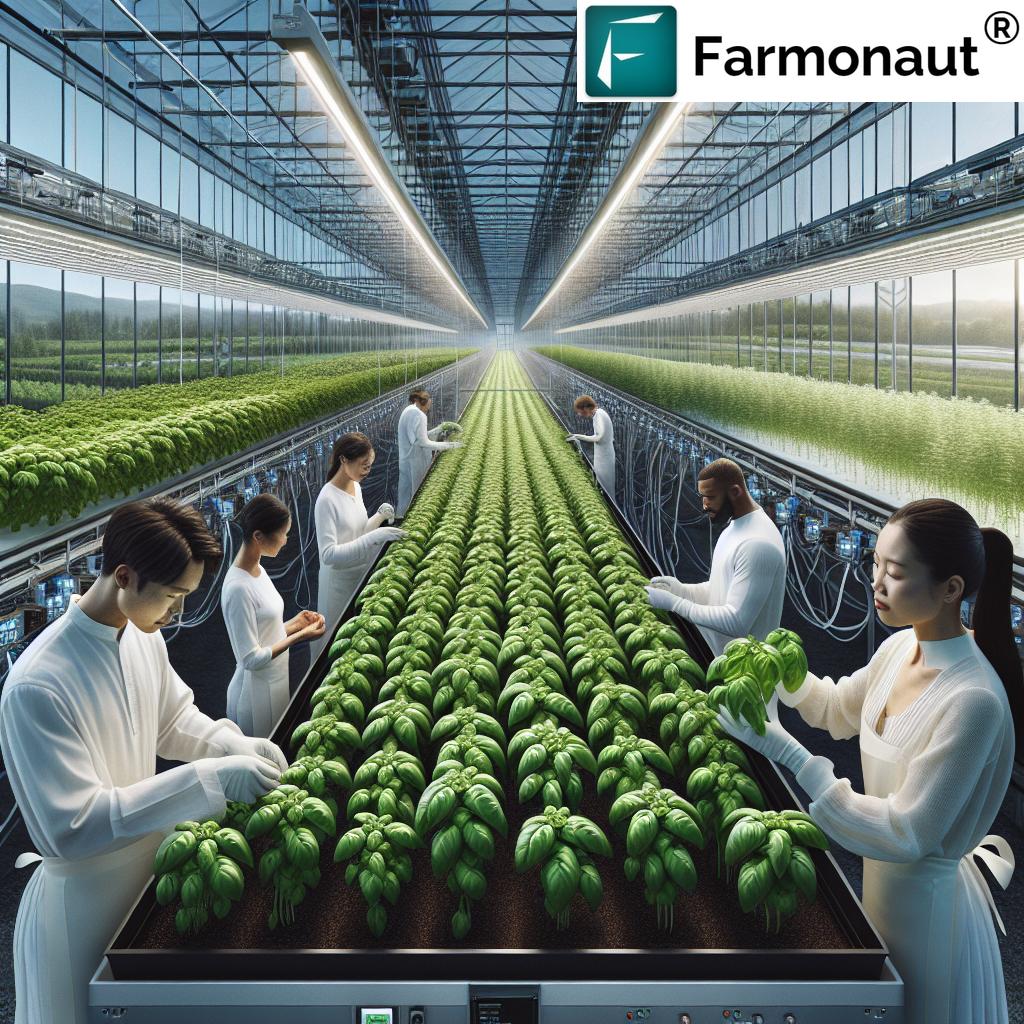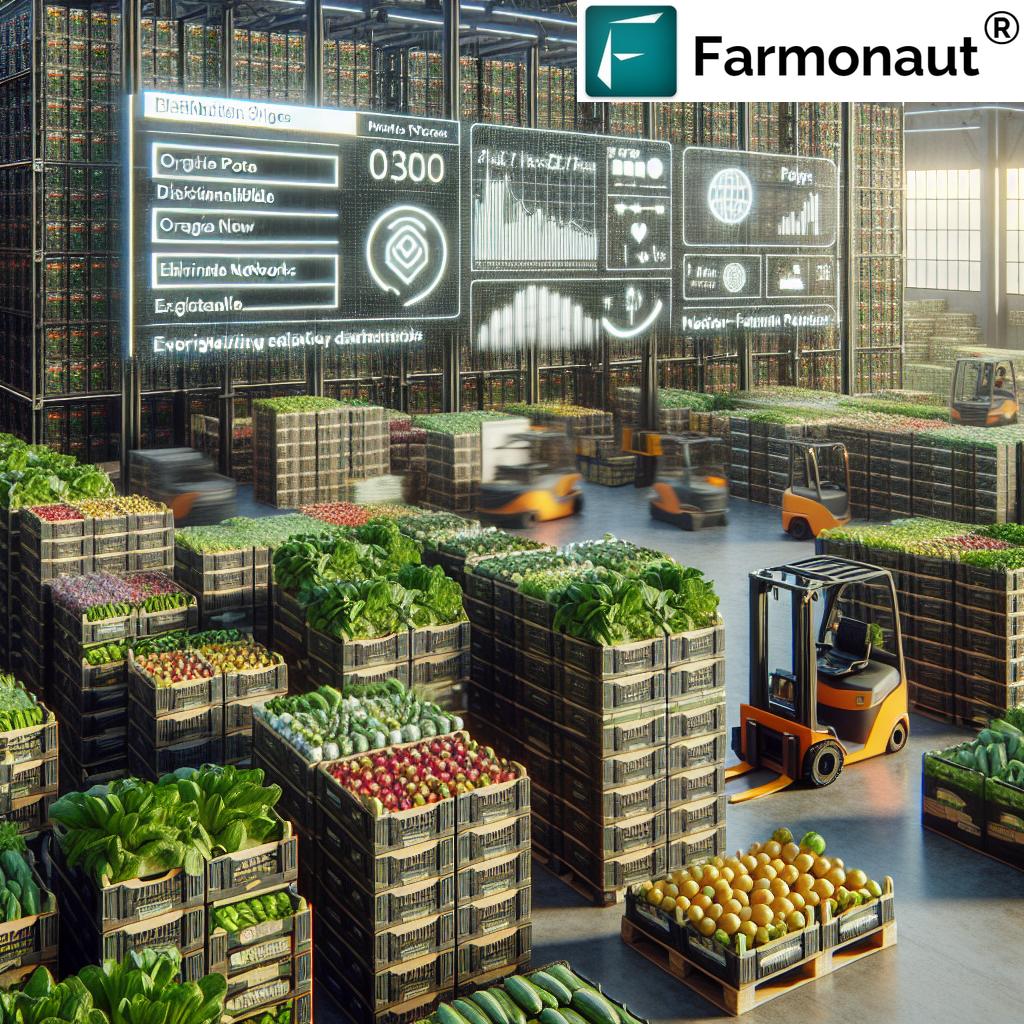Revolutionizing Sustainable Agriculture: How Controlled Environment Farming is Transforming New Jersey’s Fresh Produce Industry
“Controlled environment agriculture can extend produce shelf life by up to 50%, reducing food waste significantly.”
In the heart of the Garden State, a revolution is taking root. New Jersey, long known for its rich agricultural heritage, is now at the forefront of a transformative movement in sustainable farming. As we delve into the world of controlled environment agriculture (CEA), we’ll explore how this innovative approach is reshaping the landscape of fresh produce production, distribution, and consumption.
At Farmonaut, we’re passionate about advancing agricultural technology and supporting sustainable farming practices. While our focus is on providing cutting-edge satellite-based farm management solutions, we’re excited to share insights into the broader innovations happening in the agricultural sector, particularly in controlled environment agriculture.
The Rise of Controlled Environment Agriculture in New Jersey
Controlled environment agriculture represents a paradigm shift in how we grow food. By utilizing advanced greenhouse technology and proprietary software, CEA allows for year-round production of high-quality, locally grown produce. This method is particularly impactful in regions like New Jersey, where traditional outdoor farming is limited by seasonal changes.

The growth of CEA in New Jersey has been nothing short of remarkable. In recent years, we’ve witnessed a surge in innovative greenhouse facilities and vertical farms across the state. These operations are not only producing an array of fresh vegetables and herbs but are also setting new standards for sustainability and efficiency in agriculture.
The Environmental Impact of CEA
One of the most significant advantages of controlled environment agriculture is its reduced environmental footprint compared to traditional farming methods. Let’s break down some key aspects:
- Water Conservation: CEA systems typically use 70-95% less water than conventional agriculture, a crucial factor in an era of increasing water scarcity.
- Pesticide Reduction: The controlled environment significantly reduces the need for pesticides, promoting healthier produce and ecosystems.
- Land Efficiency: Vertical farming techniques allow for much higher yields per square foot, reducing the overall land footprint of agriculture.
- Reduced Food Miles: By growing produce closer to urban centers, CEA drastically cuts down on transportation emissions.
These environmental benefits align closely with our mission at Farmonaut. While we focus on providing satellite-based crop health monitoring and AI-driven advisory systems for outdoor farming, the principles of resource efficiency and sustainability are at the core of both CEA and our technology solutions.
Innovative Technologies Driving CEA
The success of controlled environment agriculture in New Jersey is largely due to the integration of cutting-edge technologies. Some of the key innovations include:
- LED Lighting Systems: Specialized LED lights mimic and optimize sunlight, allowing for precise control over plant growth cycles.
- Hydroponic and Aeroponic Systems: These soil-less growing methods maximize nutrient uptake and water efficiency.
- Climate Control Software: Advanced algorithms maintain optimal temperature, humidity, and CO2 levels for each crop variety.
- IoT Sensors: Real-time monitoring ensures ideal growing conditions and early detection of any issues.
While Farmonaut’s focus is on satellite-based technologies for outdoor farming, we recognize the importance of these indoor farming innovations. Our Jeevn AI Advisory System, for instance, provides personalized farm advice based on real-time data, a concept that aligns well with the data-driven approach of CEA.
The Economic Impact of CEA in New Jersey
The growth of controlled environment agriculture is not just an environmental win; it’s also providing significant economic benefits to New Jersey:
- Job Creation: CEA facilities are creating new employment opportunities in both high-tech and traditional agricultural roles.
- Year-Round Production: Unlike traditional farming, CEA allows for continuous production, stabilizing income for farmers and ensuring a steady supply of fresh produce.
- Local Economic Boost: By keeping food production local, CEA helps retain economic value within New Jersey communities.
At Farmonaut, we understand the importance of economic sustainability in agriculture. Our platform aims to improve farm productivity and efficiency, complementing the economic benefits brought by CEA to the agricultural sector.
Comparative Analysis: Traditional vs. Controlled Environment Agriculture
| Factor | Traditional Agriculture | Controlled Environment Agriculture |
|---|---|---|
| Water Usage (gallons/acre) | 100,000 – 1,000,000 | 5,000 – 50,000 |
| Pesticide Use (lbs/acre) | 2 – 12 | 0 – 0.5 |
| Land Efficiency (yield/acre) | 1x | 10x – 20x |
| Food Miles (avg. distance to market) | 1,500 miles | 50 – 100 miles |
| Growing Season (months/year) | 3 – 9 | 12 |
| Energy Consumption (kWh/lb produce) | 0.1 – 0.3 | 0.5 – 1.0 |
| Shelf Life of Produce (days) | 3 – 7 | 14 – 21 |
| Carbon Footprint (lbs CO2/lb produce) | 2 – 5 | 1 – 3 |
This comparison clearly illustrates the significant advantages of CEA in terms of resource efficiency and environmental impact. While traditional agriculture still plays a crucial role in our food system, the benefits of CEA are undeniable, especially in urban and peri-urban areas like those found in New Jersey.
Challenges and Future Outlook
Despite its many advantages, controlled environment agriculture faces some challenges:
- High Initial Costs: Setting up CEA facilities requires significant upfront investment.
- Energy Consumption: While more efficient overall, CEA can be energy-intensive, particularly in terms of lighting and climate control.
- Limited Crop Variety: Not all crops are currently suitable for CEA production, though research is expanding the possibilities.
However, the future looks bright for CEA in New Jersey and beyond. Ongoing research and technological advancements are addressing these challenges, making CEA more accessible and versatile. At Farmonaut, we’re excited about the potential synergies between our satellite-based technologies and CEA systems, particularly in areas like resource optimization and predictive analytics.
“New Jersey’s CEA industry has grown by 200% in the last 5 years, transforming the state’s fresh produce market.”
The Role of Technology in Modern Agriculture
As we’ve seen with controlled environment agriculture, technology plays a crucial role in advancing sustainable farming practices. At Farmonaut, we’re proud to contribute to this technological revolution in agriculture through our satellite-based farm management solutions. Our platform offers:
- Real-time Crop Health Monitoring: Using multispectral satellite imagery, we provide farmers with up-to-date information on crop health, helping them make informed decisions about irrigation and pest management.
- AI-powered Advisory System: Our Jeevn AI system offers personalized recommendations based on real-time data and expert knowledge, helping farmers optimize their operations.
- Blockchain-based Traceability: We offer solutions to enhance transparency in agricultural supply chains, a feature that complements the local, traceable nature of CEA produce.
While our focus is on outdoor farming, many of the principles and technologies we use can be adapted or integrated with CEA systems, creating a more holistic approach to sustainable agriculture.

The Consumer Perspective: Benefits of CEA Produce
The rise of controlled environment agriculture in New Jersey is not just beneficial for farmers and the environment; it’s also bringing significant advantages to consumers:
- Year-round Availability: CEA allows for consistent production of fresh produce regardless of season, ensuring a stable supply of local fruits and vegetables.
- Enhanced Freshness: With significantly reduced travel times from farm to table, CEA produce often reaches consumers at peak freshness.
- Improved Nutritional Value: Controlled growing conditions can lead to produce with higher nutritional content compared to some conventionally grown alternatives.
- Reduced Pesticide Exposure: The controlled environment drastically reduces the need for pesticides, resulting in cleaner produce for consumers.
These benefits align well with growing consumer demand for fresh, local, and sustainably produced food. As awareness of CEA grows, we anticipate increasing consumer preference for these products in New Jersey and beyond.
Sustainability Initiatives and Partnerships
The success of controlled environment agriculture in New Jersey is not just about individual companies or facilities; it’s about a broader commitment to sustainability across the agricultural sector. Many CEA operations are actively engaging in sustainability initiatives, such as:
- Renewable Energy Integration: Implementing solar panels and other renewable energy sources to power CEA facilities.
- Waste Reduction Programs: Developing composting and recycling systems to minimize waste from CEA operations.
- Community Engagement: Partnering with local schools and organizations to educate about sustainable farming practices.
At Farmonaut, we share this commitment to sustainability. Our carbon footprinting feature, for instance, helps agribusinesses monitor and reduce their environmental impact, complementing the sustainability efforts of CEA operations.
The Future of Agriculture: Integrating CEA and Traditional Farming
As we look to the future of agriculture in New Jersey and beyond, it’s clear that both controlled environment agriculture and traditional farming will play crucial roles. The key lies in finding ways to integrate these approaches for maximum sustainability and efficiency:
- Hybrid Farming Models: Combining outdoor farming with CEA techniques to optimize production based on crop type and season.
- Data Sharing: Leveraging data from CEA operations to inform and improve traditional farming practices, and vice versa.
- Resource Optimization: Using CEA principles to enhance resource use efficiency in traditional farming settings.
At Farmonaut, we’re excited about the potential for our satellite-based technologies to bridge the gap between CEA and traditional farming. Our platform’s ability to provide real-time data and insights can be valuable for both types of agricultural operations, helping to create a more integrated and sustainable food production system.
Educational Initiatives and Workforce Development
The growth of controlled environment agriculture in New Jersey is creating new opportunities for education and career development in the agricultural sector. We’re seeing:
- Specialized Training Programs: Universities and technical schools developing courses focused on CEA technologies and management.
- Internship Opportunities: CEA facilities partnering with educational institutions to provide hands-on experience for students.
- Research Collaborations: Partnerships between CEA companies and research institutions to advance sustainable farming techniques.
These initiatives are crucial for building a skilled workforce capable of driving innovation in sustainable agriculture. At Farmonaut, we support these educational efforts through our technology platform, which can be used as a learning tool for students and professionals interested in precision agriculture and sustainable farming practices.
The Global Context: New Jersey’s Role in Advancing Sustainable Agriculture
The advancements in controlled environment agriculture happening in New Jersey have implications far beyond the state’s borders. As a leader in this field, New Jersey is:
- Setting Standards: Establishing best practices for sustainable urban and peri-urban agriculture that can be applied globally.
- Driving Innovation: Fostering technological advancements that can be adapted to various climates and environments worldwide.
- Addressing Global Challenges: Demonstrating solutions to issues like food security, water scarcity, and climate change impacts on agriculture.
At Farmonaut, we recognize the global nature of agricultural challenges and solutions. Our satellite-based technology is designed to be applicable across different geographies, complementing the localized innovations of CEA with a global perspective on sustainable farming practices.
Conclusion: A Sustainable Future for New Jersey Agriculture
The transformation of New Jersey’s fresh produce industry through controlled environment agriculture represents a significant step towards a more sustainable and resilient food system. By leveraging advanced technologies, optimizing resource use, and prioritizing environmental stewardship, CEA is setting new standards for what’s possible in modern agriculture.
As we’ve explored, the benefits of CEA extend from environmental conservation to economic growth, from enhanced food security to improved consumer experiences. While challenges remain, the trajectory is clear: controlled environment agriculture will play an increasingly important role in shaping the future of food production, not just in New Jersey, but around the world.
At Farmonaut, we’re committed to supporting this agricultural revolution through our innovative satellite-based farm management solutions. While our focus is on enhancing outdoor farming practices, we see great potential for synergy between our technologies and CEA systems. Together, these approaches can create a more sustainable, efficient, and productive agricultural sector capable of meeting the challenges of the 21st century.
As we look to the future, it’s clear that the integration of diverse farming methods, supported by cutting-edge technology and a commitment to sustainability, will be key to feeding a growing population while preserving our planet. New Jersey’s leadership in controlled environment agriculture is not just transforming the state’s fresh produce industry; it’s contributing to a global movement towards more sustainable and innovative farming practices.
FAQ Section
- What is Controlled Environment Agriculture (CEA)?
CEA is a technology-based approach to food production that provides protection and maintains optimal growing conditions throughout the development of the crop. It optimizes the use of resources such as water, energy, space, capital and labor. - How does CEA contribute to sustainability?
CEA contributes to sustainability by significantly reducing water usage, minimizing pesticide use, increasing land efficiency, and reducing food miles. It also allows for year-round production, reducing the need for long-distance transportation of produce. - What types of crops can be grown using CEA?
While CEA is particularly effective for leafy greens, herbs, and certain fruits like tomatoes and strawberries, ongoing research is expanding the range of crops that can be efficiently grown in controlled environments. - How does CEA compare to traditional farming in terms of energy use?
CEA typically uses more energy per pound of produce due to the need for artificial lighting and climate control. However, this is often offset by higher yields, reduced transportation needs, and lower water and pesticide use. - Is produce from CEA as nutritious as traditionally grown produce?
Yes, and in some cases, it can be more nutritious. The controlled environment allows for optimization of growing conditions, which can lead to produce with higher nutritional content.
Earn With Farmonaut: Affiliate Program
Earn 20% recurring commission with Farmonaut’s affiliate program by sharing your promo code and helping farmers save 10%. Onboard 10 Elite farmers monthly to earn a minimum of $148,000 annually—start now and grow your income!
Farmonaut Subscriptions
Ready to revolutionize your farming practices? Explore Farmonaut’s solutions:
For developers interested in integrating our technology, check out our API and API Developer Docs.







